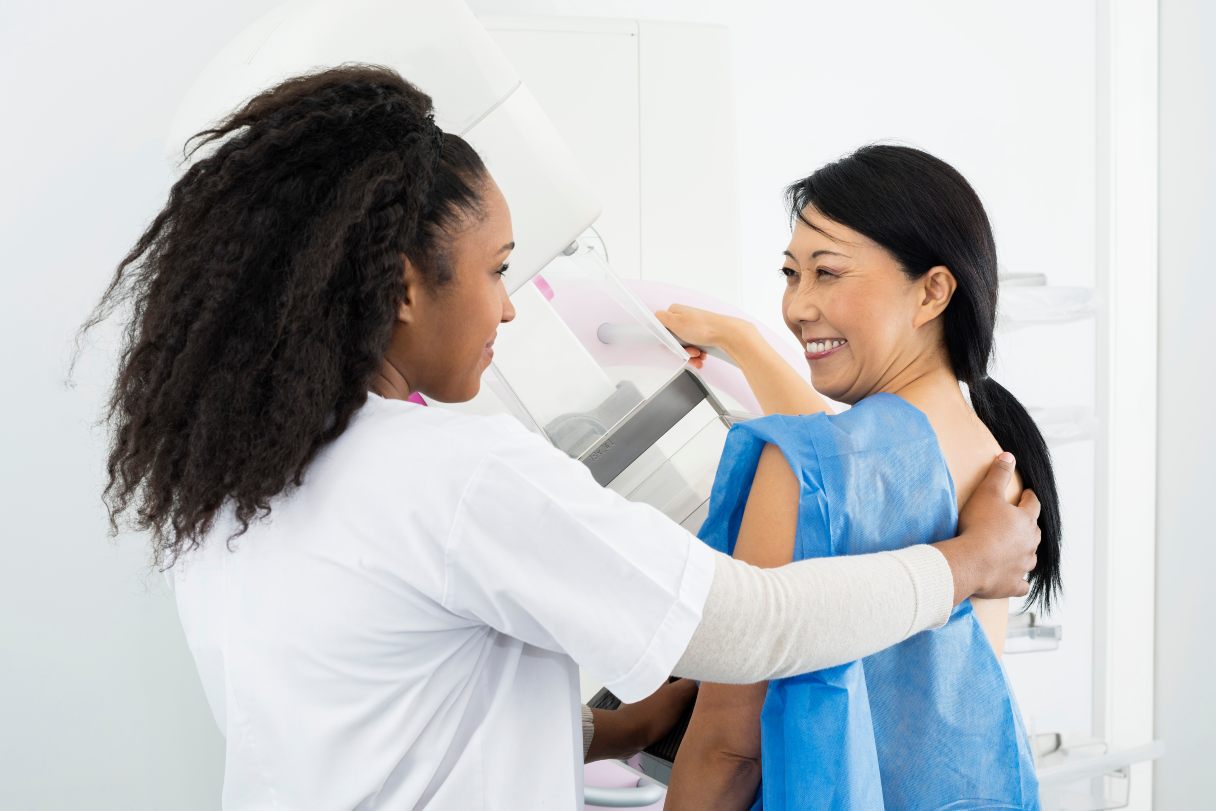With aging, your body naturally changes, and your breasts are no exception. You might experience a loss of tissue and fat, changes in your breast density, structural changes to your breast or changes in skin texture. Recognizing these changes can help you understand what's typical and when to seek medical advice. And as part of preventive healthcare, mammograms are essential for safeguarding your breast health as you age.
Explore our guide to understanding mammograms, what to expect and more.
What Is a Mammogram?
A mammogram is a specialized X-ray imaging technique to detect changes in breast tissue, lumps, abnormalities or calcifications that may indicate cancer. Radiologists assess images for signs of cancer, underscoring the mammogram's value as a diagnostic tool. It is vital for identifying tumors and abnormal growths in breast tissue, often before you notice symptoms.1
This early detection is crucial for successful treatment outcomes and is a cornerstone of preventive healthcare.
Type of Mammograms
Understanding the different types and modalities of mammograms can help you know what to expect and why each type of women's health screening is important.
- Screening mammograms. Routine checks for women without symptoms are essential for detecting changes in breast tissue.1
- Diagnostic mammograms. Used when a screening mammogram reveals something unusual, these provide a thorough examination.1
Mammogram modalities (technology)
While mammography is currently the best available screening tool for breast cancer, it does not detect all types of breast cancers. Breast tomosynthesis is a digital technology that addresses some limitations of standard mammography but may not yet be universally available in all imaging facilities.2
Discuss these options with your healthcare provider to determine the best approach for you, considering factors like breast density and others.
Here is a brief explanation of each option:2
- 2D mammogram. This captures two-dimensional (2D) images, which are effective but less detailed than newer technologies. X-ray exams are essential for diagnosing and treating medical conditions by creating images of the body's interior using a small dose of ionizing radiation. X-rays are the most widely used form of medical imaging and have been in use for a long time.
- 3D mammogram. Breast tomosynthesis, also known as three-dimensional (3D) mammography and digital breast tomosynthesis (DBT), is an advanced technique for breast imaging. It utilizes a low-dose X-ray system and computer reconstructions to generate 3D breast images, aiding in the early detection and diagnosis of breast disease.
Mammogram Costs
The national average cost* of a 2D mammogram is $520 but can range from $405 to $1,014. The average cost* of a 3D mammogram is $653 but can vary between $504 and $1,274. The cost can vary depending on where the mammogram is performed, as well as other factors.3
Where Can I Get a Mammogram?
Mammograms can be scheduled at hospitals, specialized breast centers and imaging clinics.4 Radiography technologists, trained in breast imaging techniques, will perform your mammogram, ensuring your comfort and the clarity of images.
How Often Is It Recommended to Get a Mammogram Based on My Age?
Breast cancer screenings are not one-size-fits-all; the importance and frequency of these screenings vary across different age groups. For younger women, especially those who have lower chances of getting cancer, the decision to start screening is part personal choice and part assessment. As women age, the likelihood of developing breast cancer increases, making regular screenings more critical.
The American Cancer Society provides clear recommendations on mammography screening. These guidelines are designed to balance the benefits of early detection with the potential of overscreening:5
- Ages 40 to 44. Mammography is available based on personal choice and should be discussed with a healthcare provider. The American Cancer Society recommends having mammograms done yearly for individuals in this age group.
- Ages 45 to 54. Annual mammography screenings are recommended to maximize early detection benefits.
- Ages 55 and older. Based on health and personal preferences, women can transition to screening every two years or continue with annual screenings.
Individuals with a strong family history or genetic mutations may need earlier screenings and possibly additional imaging, such as a breast MRI.5 Women with dense breast tissue might benefit from 3D mammography to provide clearer images.2
Breast Cancer Screening Guidelines for Transgender and Nonbinary Individuals
Recent research published in Seminars in Oncology Nursing suggests the need for a more comprehensive study of the increased cancer incidence among transgender and nonbinary individuals. The research highlights the barriers that transgender and nonbinary people face when trying to access gender-affirming healthcare and cancer screening. Here are some of these barriers:6
- Discrimination can negatively impact cancer screening, access to oncology services and treatment adherence.
- Lack of culturally safe health screening can lead to cancer going undetected.
- Poverty can limit access to social services, health resources, insurance and mental health support.
Transgender women and those on hormone therapy for more than five years should consider regular screenings due to increased breast tissue density. Transgender men and those who haven't had top surgery should follow age-based guidelines. For those postsurgery, you should discuss the need for screenings and exams with your provider.7
Benefits of Getting Regular Mammograms
Mammograms offer significant benefits by finding breast cancer early when lesions are smaller and easier to successfully treat. Here’s how they help:
- Early detection. Mammograms can identify tumors that are too small to be felt, catching cancer early when it’s most treatable.
- Peace of mind. Anxiety often arises due to uncertainties surrounding breast cancer.8 While there are no guarantees, mammograms provide significant reassurance if results are normal.
- Informed decisions. Regular mammograms contribute valuable information to help you and your healthcare provider make informed decisions about your health.
- Continuity. Maintaining the same facility and technologist for mammograms or using interoperable technology to share records is important for identifying breast cancer at earlier stages, reducing recall for additional images and potentially decreasing unnecessary procedures and biopsies.
- Higher survival rates. The five-year survival rate for breast cancer is nearly 100% when it's found before it spreads.9
How to Prepare for Your Mammogram
Before your mammogram, avoid using deodorants, powders or lotions under your arms or on your breasts, as these products can interfere with results. Wear a two-piece outfit for convenience. Schedule your mammogram during a time when your breasts are not tender. Discuss any changes or concerns with your doctor, and bring previous results if visiting a new facility.10
During Your Mammogram
During the mammogram, you will stand in front of the machine, and your breast rests on a clear plate for imaging. The machine takes X-rays of your breast from multiple angles to ensure a thorough examination. Compression is important as it spreads the tissue out, allowing for a clearer, more detailed X-ray image. The pressure may feel uncomfortable but only lasts a few seconds. The process is repeated for different views of each breast. After the mammogram, you can resume normal activities immediately.10
Discomfort during the mammogram process is not uncommon, but compression is necessary to obtain clear images. Scheduling your mammogram during times when breasts are least tender and discussing concerns with technologists can help manage discomfort.11
Your mammogram results are usually available within a few weeks. If follow-up testing is required, your doctor may contact you sooner. Timely results help plan necessary actions.
Understanding Your Mammogram Report
Did you know that the U.S. Food and Drug Administration (FDA) requires anyone who has had a mammogram to receive a report written in terms easily understood by a layperson?12 When you get your report, you should take the time to look through it and note any follow-up questions for your doctor. The following is a breakdown of what to expect and how to interpret your mammogram results.
Key components of mammogram results
A medical doctor called a radiologist will categorize your mammogram results using a numbered system called the Breast Imaging Reporting and Data System (BI-RADS). This tool is commonly used to categorize mammogram findings and provides a clear framework for understanding the results. Categories range from zero to six as follows:13
- BI-RADS 0 — incomplete. This category indicates that the mammogram results are unclear or incomplete and additional imaging is required. This may involve further mammography views or an ultrasound to clarify any potential abnormalities. The radiologist may also compare the current mammogram with previous ones to detect any changes over time.
- BI-RADS 1 — negative. This score means that there are no significant findings. In other words, your breast tissue appears normal.
- BI-RADS 2 — benign (noncancerous) findings. This category indicates no signs of cancer but notes benign cysts or masses. The report note will be used for future comparisons. Noncancerous findings may include fibroadenoma (a solid, firm or rubbery lump made of glandular or connective tissue) or cyst (a fluid-filled sac).
- BI-RADS 3 — abnormal with a low likelihood of cancer. An abnormality is present, but around 98% of the time is found to be benign. Short-term follow-up with another type of imaging or a diagnostic mammogram in six months is often recommended to monitor changes.
- BI-RADS 4 — suspicious finding. This category indicates that the radiologist found a suspicious abnormality with a moderate chance of being cancerous. On a case-by-case basis, your doctor may recommend a biopsy or follow-up diagnostic testing such as a breast ultrasound.
- BI-RADS 5 — highly suggestive of malignancy. This finding indicates that the radiologist is reasonably certain an abnormality is cancerous. The next step is a biopsy to confirm a diagnosis.
- BI-RADS 6 — biopsy-confirmed cancerous lesion. This category applies to mammogram findings that have already been confirmed as cancer by a previous biopsy.
The BI-RADS system helps medical providers accurately interpret mammogram results, guiding the next steps in your diagnosis and treatment.
Taking Charge of Your Breast Health
Taking control of your breast health by having regular mammograms is an empowering step in the fight against breast cancer. When you understand how your body changes with age and what increases your likelihood of getting cancer, the varying screening guidelines make more sense, allowing you to make informed decisions tailored to your personal and medical needs.
Remember, early detection can be life-saving, making it essential to follow recommended screening schedules and consult with healthcare professionals about any concerns you might have.
Managing Health and Wellness Costs With the CareCredit Credit Card
If you are looking for an option to help manage your health and wellness costs, consider financing with the CareCredit credit card. The CareCredit credit card can help you pay for the care you want and need and make payments easy to manage.** Use our Acceptance Locator to find a provider near you that accepts CareCredit. Continue your wellness journey by downloading the CareCredit Mobile App to manage your account, find a provider on the go and easily access the Well U blog for more great articles, podcasts and videos.
Your CareCredit credit card can be used in so many ways within the CareCredit network including vision, dentistry, cosmetic, pet care, hearing, health systems, dermatology, pharmacy purchases and spa treatments. How will you invest in your health and wellness next?
Author Bio
Pamela Cagle, R.N., has extensive experience in a range of clinical settings, including ER, surgical and cardiovascular. For the past decade, she has leveraged her nursing experience in writing for health and technology publications such as AARP, VKTR, National Council on Aging and others. She is passionate about blending her medical and storytelling expertise to bring authenticity to health and wellness topics.







